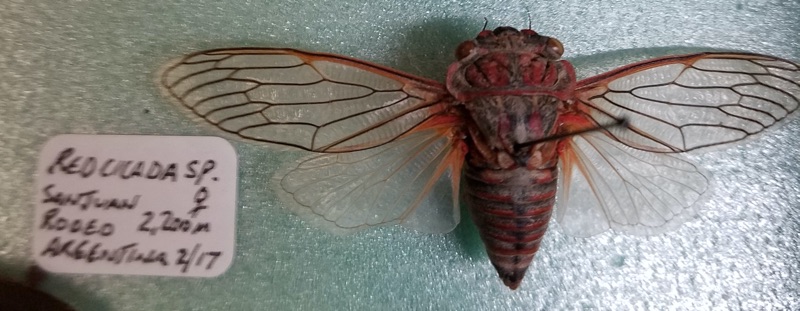Calliopsida cinnabarina aka the Cinnabar Cicada is named for its coloration, which resembles the red mineral cinnabar (a source of mercury). It is found in Argentina.
Photo by cicada collector Richard Newfrock:

Thanks to Geert Goemans for the ID of the photo.
Luis Delétang’s notes on the wings of C. cinnabarina from Monografia de los cicádidos (Cicadidæ) Argentinos y relación de estos con la fauna sudamericana. 1923. Translated from Spanish to English.
Only once have I been able to study a case of nervation suppression. A (J of Chonosia cinnabarina (Berg) {Tettigades cinnabarina Berg) from the province of Mendoza presents tegminas whose transverse ribs of the seventh apical cells have disappeared and this suppression has given rise to the formation, with the help of the cubital cells, of abnormal cells comparable to the base apses of the wings.
Luis Delétang general notes on C. cinnabarina from Contribución al estudio de los Cicádidos (Cicadidae) argentinos (Hemiptera-Homoptera) ensayo filogenético. 1919. Translated from Spanish to English.
This species, common in the provinces of Cuyo, has been described by Berg on specimens from the province of Mendoza, and recently I received it from the province of Tucuman. The red coloration of the body, the preanal segment, the apical cells of the tegminas, etc., distinguish well the cinnabarina of its Argentine congener.
Scientific classification:
Family: Cicadidae
Subfamily: Cicadettinae
Tribe: Tettigadini
SubTribe: Tibicininae
Genera: Calliopsida
Species: Calliopsida cinnabarina (Berg, 1879)
More information:
- A photo of a live Cinnabar Cicada.
- Monografia de los cicádidos (Cicadidæ) Argentinos y relación de estos con la fauna sudamericana. Delétang, Luis F. 1923. Anales del Museo Nacional de Historia Natural de Buenos Aires. Vol 31. Page 633. Read it on the Biodiversity Heritage Library.
- Contribución al estudio de los Cicádidos (Cicadidae) argentinos (Hemiptera-Homoptera) ensayo filogenético. Delétang, Luis F. 1919. Anales de la Sociedad CientÃfica Argentina. Vol 88. Page 92. Read it on the Biodiversity Heritage Library.